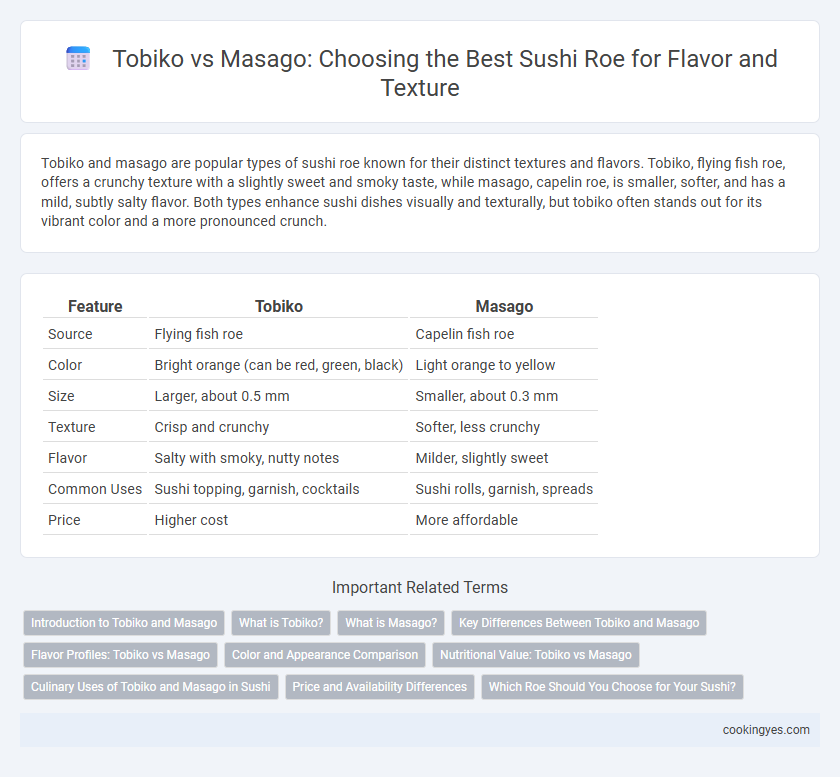Tobiko and masago are popular types of sushi roe known for their distinct textures and flavors. Tobiko, flying fish roe, offers a crunchy texture with a slightly sweet and smoky taste, while masago, capelin roe, is smaller, softer, and has a mild, subtly salty flavor. Both types enhance sushi dishes visually and texturally, but tobiko often stands out for its vibrant color and a more pronounced crunch.
Table of Comparison
| Feature | Tobiko | Masago |
|---|---|---|
| Source | Flying fish roe | Capelin fish roe |
| Color | Bright orange (can be red, green, black) | Light orange to yellow |
| Size | Larger, about 0.5 mm | Smaller, about 0.3 mm |
| Texture | Crisp and crunchy | Softer, less crunchy |
| Flavor | Salty with smoky, nutty notes | Milder, slightly sweet |
| Common Uses | Sushi topping, garnish, cocktails | Sushi rolls, garnish, spreads |
| Price | Higher cost | More affordable |
Introduction to Tobiko and Masago
Tobiko and Masago are popular sushi roe known for their distinct textures and flavors. Tobiko is the roe of flying fish, characterized by its larger, crunchy eggs and vibrant orange color, offering a mildly smoky taste. Masago, derived from capelin fish, has smaller eggs that provide a crunchier texture with a slightly saltier flavor, often used as a cost-effective alternative to Tobiko in sushi dishes.
What is Tobiko?
Tobiko is the roe of flying fish, prized for its small, crunchy texture and vibrant orange color, often used as a garnish in sushi dishes. It has a slightly sweet and smoky flavor with a subtle saltiness that enhances the overall taste of sushi rolls. Compared to masago, tobiko is larger in size and offers a more pronounced crunch, making it a popular choice for adding visual appeal and texture to sushi.
What is Masago?
Masago is the roe of the capelin fish, a small forage fish found in cold ocean waters, often used in sushi dishes due to its crunchy texture and mildly sweet flavor. It features tiny, orange to yellowish eggs that are smaller than tobiko, the flying fish roe, and is commonly used as a colorful garnish or ingredient in rolls and sushi bowls. Known for its affordability compared to tobiko, masago offers a subtle taste and a vibrant look, enhancing both the presentation and flavor profile of sushi.
Key Differences Between Tobiko and Masago
Tobiko and Masago are distinct types of fish roe commonly used in sushi, with Tobiko originating from flying fish and characterized by its larger, crunchy texture and vibrant orange color. Masago, derived from capelin fish, features smaller eggs with a milder flavor and a more subtle, softer crunch. Tobiko tends to have a slightly sweeter taste and is often used for its striking visual appeal, while Masago is favored for its affordability and delicate texture in sushi rolls.
Flavor Profiles: Tobiko vs Masago
Tobiko features a crunchy texture with a mildly sweet and smoky flavor, often enhanced by wasabi or yuzu infusions, making it a vibrant topping in sushi dishes. Masago offers a smaller, finer texture with a subtly salty and slightly sweet taste that blends smoothly into rolls and garnishes. Both tobiko and masago provide distinct flavor profiles that enhance sushi's complexity, but tobiko delivers a more pronounced crunch and smoky note compared to masago's delicate sweetness.
Color and Appearance Comparison
Tobiko roe showcases vibrant, larger eggs with a bright orange color that adds a striking visual appeal to sushi dishes. Masago roe features smaller, finer grains with a more muted yellow-orange hue, often appearing less glossy compared to tobiko. The distinct texture and vivid coloration of tobiko make it a popular choice for enhancing the sushi's aesthetic presentation.
Nutritional Value: Tobiko vs Masago
Tobiko contains higher levels of protein and omega-3 fatty acids compared to Masago, making it a more nutrient-dense option for sushi roe. Masago is lower in fat but still provides a good source of vitamins B12 and E, supporting energy metabolism and antioxidant functions. Both tobiko and masago offer essential minerals like phosphorus and selenium, but tobiko generally delivers a richer nutritional profile per serving.
Culinary Uses of Tobiko and Masago in Sushi
Tobiko, known for its larger, crunchy texture and vibrant orange color, adds a visually appealing pop and subtle smoky flavor to sushi rolls and sashimi dishes. Masago, smaller and softer with a mild taste, is commonly used as a garnish or mixed into sauces to enhance flavor without overpowering other ingredients. Both tobiko and masago elevate sushi presentation and offer unique textural contrasts essential for an authentic sushi experience.
Price and Availability Differences
Tobiko, derived from flying fish roe, generally commands a higher price due to its vibrant color, larger size, and crunchy texture, making it a premium choice in sushi dishes. Masago, sourced from capelin roe, is more widely available and affordable, often used as an economical substitute with a finer texture and milder flavor. The price difference between Tobiko and Masago can vary significantly depending on the quality and regional supply, influencing restaurant menus and consumer preferences.
Which Roe Should You Choose for Your Sushi?
Tobiko, known for its larger, crunchier texture and vibrant orange color, offers a slightly sweet and smoky flavor ideal for adding visual appeal and a burst of crispiness to sushi rolls. Masago features smaller, softer grains with a mild, slightly salty taste, making it a versatile roe that absorbs surrounding flavors well and is often used as a cost-effective alternative in sushi toppings. Choosing between Tobiko and Masago depends on your desired texture and flavor profile: Tobiko for a bold crunch and striking appearance, or Masago for subtlety and smoothness in your sushi experience.
Tobiko vs Masago for Roe Infographic

 cookingyes.com
cookingyes.com